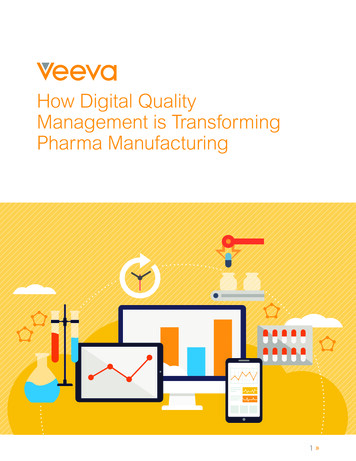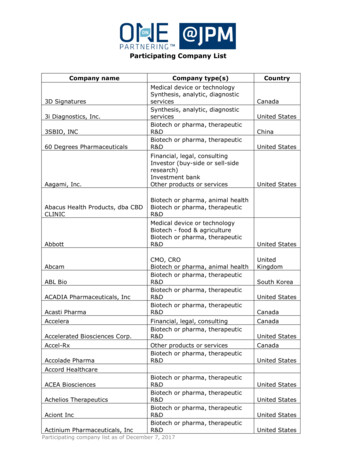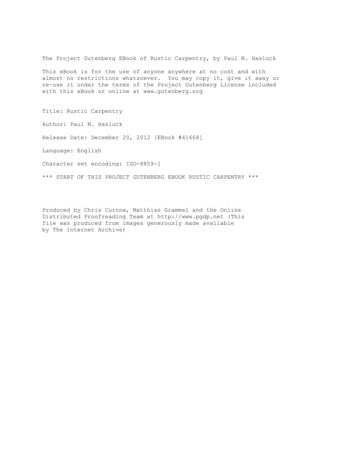
Transcription
How Digital QualityManagement is TransformingPharma Manufacturing1»
eBookForewordNew-market demands, increasingly complex supply chains, and changing regulations are forcingmanufacturers to re-evaluate their disjointed legacy systems and processes. These disconnected systemscreate business gaps between manufacturing and quality management processes, making it hard to trackfast-changing regulations and hit time-to-market goals.So, how can pharma manufacturing become more agile, data-driven, and future-ready?Digital transformation is the answer.Embracing digital quality management, manufacturers can increase agility and collaboration across thesupply chain to meet continually changing market demands. Enabling technologies such as cloud computing,artificial intelligence, and the Internet of Things allow manufacturers to scale operations seamlessly for newtherapies like precision medicine. And mobile devices running cloud applications can provide operators withreal-time access to up-to-date content.Digital quality management can also streamline discrete quality processes, providing the flexibility neededacross the product lifecycle, from clinical to commercial. For example, connecting SOP management withtraining assignments and delivery enables version-based training automation and faster time to qualification.The following collection of articles provides quality and compliance teams with a deeper understanding of howdigital technologies enable a connected shop floor for better quality products and faster time-to-market.ARTICLE 1How digital transformation is meeting the new demands of quality managementThe first article in this collection, “Digital transformation: meeting the new demands of quality managementin manufacturing,” explains how digital transformation is improving pharmaceutical processes across theindustry. Powered by cloud computing, artificial intelligence, and the Internet of Things (IoT), digital qualitymanagement enables manufacturers to reliably and economically produce new therapies at scale.Read it here ARTICLE 2How a connected shop floor can build operational agility and enable 24/7 manufacturingThe next piece, “Modernizing manufacturing through a connected shop floor,” explores how a digitallyconnected shop floor can support 24/7 manufacturing and speed production. Electronic devices provideup-to-date content and real-time visibility to operators that drive informed decision-making. The article alsohighlights specific examples of how mobile devices and intuitive applications can better support moderntraining methods, improving quality and compliance. Read it here «2»
eBookARTICLE 3How Quality 4.0 can transform manufacturing operationsThe final article, “Quality 4.0: The Foundation for a New Era of Medicine”, outlines five ways in which Quality4.0 will improve manufacturing operations, benefitting the life sciences industry. The article reinforces,with specific examples, how Quality 4.0 systems eliminate silos to meet the new demands of quality andmanufacturing and support innovation in a new era of medicine. Read it here Digital transformation is on the rise in the biopharma industry. Companies utilizing advanced digitaltechnologies are affirming leadership positions and becoming more competitive globally.The ultimate goal is to meet the current and future needs of patients. Modern digital technologies are well ontheir way to meet those expectations as market and quality demands evolve.ARTICLE 1 HOW DIGITAL TRANSFORMATION IS MEETING THE NEW DEMANDSOF QUALITY MANAGEMENT ARTICLE 2 H OW A CONNECTED SHOP FLOOR CAN BUILD OPERATIONAL AGILITYAND ENABLE 24/7 MANUFACTURING ARTICLE 3 HOW QUALITY 4.0 CAN TRANSFORM MANUFACTURING OPERATIONS «3»
EUROPEAN PHARMACEUTICAL MANUFACTUREReBookARTICLE 1Digital transformation:meeting the new demands of qualitymanagement in manufacturingBy Robert Gaertner, director of strategy for quality, Veeva SystemsRobert Gaertner, director of strategy for quality at Veeva, explains how digital transformation is improvingpharmaceutical processes across the industry.Advancing digital technology is bringing new opportunities to improve quality and efficiency in thepharmaceutical industry. Many life science organisations are transforming manual and document-centricprocesses into more data-driven ways of working. They are replacing a formerly siloed system landscape withunified and connected applications.In pharmaceutical manufacturing this addresses long-standing inefficiencies, placing product supply units in astronger position to meet future demands. It is important for manufacturing operations to become more agile,while embracing the new paradigm of precision medicine. Enabling the creation of a connected shop floorallows for real-time visibility across data and processes for better tracking and analytics. This is a pre-requisitefor adaptive manufacturing and continuous improvement.Precision medicine transforming processesEnabling technologies such as cloud computing, artificial intelligence, and the Internet of Things have reachedenterprise-scale maturity. However, the real driving force for transformation will be changing market demands.In 2018, the FDA approved 62 new therapeutic drugs, of which 25 were precision medicines.1 This emergingapproach to disease treatment targets a patient’s unique molecular and genetic profile and therefore requireschanges in the way that products are manufactured. Typically, precision medicines are made for small groupsof people with hard-to-treat illnesses. The reality is that they can be complicated to produce and difficult toscale.Additionally, with many precision therapies, the patient becomes an integral part of a highly specific end-toend manufacturing process. For example, with chimeric antigen receptor (CAR) T-cell therapy, approved forrelapsed and refractory leukaemia and lymphoma, the patient’s cells are collected at the hospital, shipped to amanufacturing centre for engineering to target the person’s specific cancer, and then sent back to the hospitalfor infusion into that patient.1 Personalized Medicine at the FDA, Progress e Outlook, Personalized Medicine Coalition «4»
ARTICLE 1 DIGITAL TRANSFORMATIONeBookThe opportunity for changeWhat are the levers to get pharma manufacturing more agile, data-driven, and ready for future demands?As an example, much of the information on the pharmaceutical shop floor is currently buried in paperbinders or siloed applications. Without centralised systems for tracking and distributing content and intuitiveapplications that offer quick access, operators are not able to easily consume the right information they needto perform their jobs. This increases the risk of human errors. Significant overhead is required to ensure thatStandard Operating Procedures and Work Instructions remain current and followed by every employee.In addition to the challenges with document-centric instructions, the systems landscape is mainlydisconnected and based on ageing technology. Companies may try to get as much value as they can fromtheir quality management and manufacturing systems by operating them past their shelf life. This practicecan actually increase costs because ageing systems tend to be over-engineered, customised, and requirefrequent maintenance. Older systems are often too rigid to adapt to new processes, manufacturing or trainingmethods, or production requirements, and they cannot efficiently scale down for small batch productionrequired for precision medicinesMatching up to other industriesThe life sciences industry has continued to lag behind other industries in the adoption of new technologies.In fact, a recent survey by Deloitte with MIT Sloan Management Review showed that only 20% of biopharmacompanies are maturing digitally.2 However, meeting the requirements for innovative therapies, such asprecision medicines, depends on the industry’s ability to leverage modern solutions. This is key to enablingtimely delivery of information to the plant floor and improving agility.One of Veeva’s customers, a large contract development and manufacturing organization for biologics,is taking a fresh approach to ensure they remain efficient and agile as they scale. Leveraging moderntechnology and its parent company’s manufacturing expertise and experience, the organization isprogressively building larger and more advanced facilities that can run continuously 24 hours a day, sevendays a week.Going mobile for greater plant agilityMobile devices are ideal for collecting and distributing real-time information to the plant floor and eliminatingpaper as the main source of information. Using tablets, operators and technicians can deliver updated contentand collect data that can be analysed for improved visibility and efficiency. Cloud applications designedspecifically for the manufacturing plant floor run on mobile devices and support manufacturing processes, withup-to-date content and seamless integration with quality management systems.Synchronising content on mobile tablets at each work station has many benefits. First, the content iscompletely accessible to operators, including for offline viewing. This eliminates having to page throughstacks of paper to find the right instructions.2 “Survey Finds Biopharma companies lag in digital transformation,” Deloitte Oct. 2018 «5»
ARTICLE 1 DIGITAL TRANSFORMATIONeBookSecond, mobile applications provide real-time visibility into quality events, allowing manufacturing and qualityteams to address and resolve issues quickly when they first come to light, before they have a bigger impact.For example, with a tablet, workers can detect deviations right on the plant floor and enter them immediatelyat the point of observation, permitting rapid triaging, impact assessment, and remedial action as quickly aspossible.Human error prevention with improved training methodsA connected shop floor supports training methods that provide the flexibility and versatility needed in modernmanufacturing. Information, such as relevant digital procedures and work instructions, can be presented toworkers at specific points in the manufacturing process, reducing complexity and, with it, variation.This targeted learning approach is replacing passive “read and understand” instructions, ensuring measurabletraining effectiveness. Companies can expect better results from training programs that are shifting fromindividual, content-driven events to learning that is deeply contextual, social, and embedded into the flowof everyday work.3 This approach ensures that individuals are not just qualified but also prepared to dotheir jobs.Training platforms that apply these techniques are catching on in the life sciences industry. By connectinglearners with training content at the time of need and according to specific learning styles, companies canchange behaviours to decrease quality events. Mapping training content to learner roles based on jobfunctions, then delivering it through a role-based, content-centric experience simplifies training, while makingit more cohesive and integrated with quality goals.The future of quality managementTransforming quality management is key to successfully gaining the agility needed for the production of newtherapies. Next-generation solutions that emphasise flexibility and efficiency position manufacturers to reapenormous benefits in simplifying and improving quality management.To meet current and future needs of patients, life-science companies can enable processes that are flexibleand always compliant. Eliminating siloed systems in favour of streamlined solutions allows for greateragility and stronger collaboration, while enhancing compliance and end-to-end control. This will help enablelife-science organisations to meet the new demands of quality management in manufacturing and helpsupport innovation in precision medicine.3 “Corporate Learning Programs Need to Consider Context, Not Just Skills,” Harvard Business Review Nov. 2017 «6»
eBookPHARMA MANUFACTURINGARTICLE 2Modernizing manufacturing througha connected shop floorEliminating siloed systems in favor of streamlined applications allows for greater agility andstronger collaboration, enabling pharma to meet the new quality management demandsBy Michael Jovanis, vice president, Vault Quality, Veeva Systems Companies want to create smarter, more agile manufacturing facilities. By digitalizingtheir content management and delivery, manufacturers can ensure operationalalignment and empower teams with access to the information they need.– Jan Paul Zonnenberg, operations management consulting partner forpharmaceutical and life sciences companies, PWCThe shop floor is ripe for digital transformation. Manufacturing operations are still mostly paper-based, withaging systems also in use long past their shelf life. Adapting to new processes, manufacturing or trainingmethods, or production requirements is difficult because processes are manual and systems are rigid orfunction in silos.As a result, companies are modernizing manufacturing operations with advanced mobile applications thatcan bring workstations online and significantly improve agility and efficiency, while maintaining quality andcompliance. With a connected shop floor, facilities can support 24/7 manufacturing and manufacturers gainreal-time visibility for greater intelligence and smarter decision-making.“Companies want to create smarter, more agile manufacturing facilities,” said Jan Paul Zonnenberg,operations management consulting partner for pharmaceutical and life sciences companies at PWC, theglobal auditing and consulting firm. “By digitalizing their content management and delivery, manufacturerscan ensure operational alignment and empower teams with access to the information they need.”Modern cloud solutions are helping companies seamlessly bring together people, processes, and technology– accelerating their digital transformation and transition to a connected shop floor.Building operational agilityThe rise of precision medicines and complexity of supply chains combined with disruptive events, such asnatural disasters or political instability, are forcing companies to re-evaluate their business agility.Precision medicines hold tremendous potential to transform clinical practices. The Food and DrugAdministration approved an all-time record 62 new therapeutic drugs last year, of which 25 were personalizedmedicine therapies. Typically made in small volumes, these therapies can be complicated to produce and«7»
ARTICLE 2 MODERNIZING MANUFACTURINGeBookdifficult to scale. Traditional, large-scale blockbuster drug manufacturing processes are not aligned withthe production of highly individualized medicines. The success and scalability of personalized medicinerequires new strategies for automation and improved workflows to produce these therapies reliably, safely,and economically.Going mobile for responsive manufacturingToday, much of the content on the manufacturing shop floor is only accessible in paper binders or siloedapplications. Without digital distribution of procedures and work instructions, it is hard to keep informationcurrent when there are frequent updates, or changes when sites or manufacturing lines produce new products.Companies face intense pressure to quickly get finished goods out the door, and any delay impacts revenue.The life sciences industry continues to lag many other industries in adoption of new technologies. In a recentsurvey by Deloitte with MIT Sloan Management Review, only 20 percent of biopharma companies arematuring digitally. Leveraging solutions to enable timely delivery of information to the plant floor and tying realtime data with quality management systems can improve agility and help manufacturers meet requirementsfor innovative therapies such as personalized medicines.Cloud applications designed specifically for the manufacturing shop floor run on mobile devices and supportmanufacturing processes with up-to-date content and seamless integration with quality management systems.A connected shop floor can drive greater manufacturing agility, and mobile devices are ideal to deliver andcollect real-time information.Devices such as tablets can deliver updated content to operators as well as provide real-time visibilityinto quality events so teams can quickly address and resolve issues before they have a bigger impact.For example, deviations detected on the shop floor are immediately entered into a tablet at the pointof observation. Instant visibility into deviations and other quality events allows for rapid triaging, impactassessment, and remedial action as quickly as possible.Companies like Samsung BioLogics, a large contract development and manufacturing organization (CDMO)for biologics, are adopting technology to ensure they remain efficient and agile as they scale. “In the currentmedicine era, CDMOS must adapt their manufacturing facilities to support multi-drug demands,” said JamesChoi, chief information officer at Samsung BioLogics. “With modern technology and automated processes, weare reducing the time it takes and number of batch losses suffered when switching between products.”Enabling 24/7 manufacturingWith paper-based processes, significant overhead is required to ensure the content that workers need tocomplete tasks is current and easily accessible. Companies that have invested in legacy systems have alsorealized these solutions cannot reliably support continuous uptime and there are long scheduled downtimesdue to system maintenance, upgrades, and re-validation. With modern technology and automated processes, we are reducing the time it takesand number of batch losses suffered when switching between products.– James Choi, chief information officer, Samsung BioLogics«8»
ARTICLE 2 MODERNIZING MANUFACTURINGeBook It’s challenging to manage, maintain, and provide continuous access to currentinformation on the manufacturing floor. Delivering content directly to manufacturingstations through a mobile application – that also offers offline access – will ensureoperators are always working from the latest procedures and make it easier for sitesto run twenty-four by seven.– James Choi, chief information officer, Samsung BioLogicsShifting to a 24/7 manufacturing facility increases utilization of equipment and sites and enables companiesto be more responsive to business demands. Modern cloud solutions are designed to have continuousuptime. Information is always accessible to operators, including for offline viewing. Synchronizing contentonto mobile tablets at each work station allows operators to quickly access correct information at the pointof need to perform their job. Eliminating paging through stacks of paper to find the right instructions drivesgreater adoption and increases operator compliance – potentially leading to fewer deviations.Increasingly, pharma manufacturing sites – especially at contract manufacturing organizations – aretransitioning to a continuous operating model. Leveraging modern technology and its parent company’smanufacturing expertise and experience in other industries, Samsung BioLogics is progressively buildinglarger and more advanced facilities that can run continuously 24 hours a day, seven days a week.“It’s challenging to manage, maintain, and provide continuous access to current information on themanufacturing floor,” said James Choi, chief information officer at Samsung BioLogics. “Delivering contentdirectly to manufacturing stations through a mobile application – that also offers offline access – will ensureoperators are always working from the latest procedures and make it easier for sites to run twenty-fourby seven.”Direct visibilityA connected shop floor has the potential to improve productivity and enable better decision-making. Managerstrack how content is consumed at each facility, station, and device, and update the content on an as-neededbasis. This functionality offers a new lens into the effectiveness of the content.For instance, managers can measure whether document-based instructions are more successful than ashort video in engaging workers and improving comprehension. Video is gaining popularity as an effectivetraining tool. Delivering video though mobile devices directly on the shop floor could improve efficiency andcompliance. Managers could see how employees are engaging with the content delivered digitally to eachstation, and, using that data, design instructions and training modules to fit with that particular task or even aparticular employee’s learning style.Centralizing quality event information provides a more complete view and enables greater insights for betterdecision-making. Data and metrics help identify trends for proactive, and eventually predictive, qualitydecisions. Teams gain a deeper understanding on how quality events are related, furthering the ability forimproving quality and manufacturing operations.«9»
ARTICLE 2 MODERNIZING MANUFACTURINGeBookQuality 4.0 and a connected ecosystemPaper-based process and legacy systems create many business gaps between manufacturing, qualitymanagement (QMS), and content management systems, making it challenging to effectively deliver qualityproducts. Innovative life sciences companies are embracing Quality 4.0 technologies to improve operationalefficiency and effectiveness and product quality.Quality 4.0 comes from Industry 4.0 and is usually defined as the adoption of new technology to improveoperational efficiency and product quality. Quality 4.0 enables quality systems to integrate seamlessly withcomplementary systems such as manufacturing execution (MES), enterprise resource planning (ERP),product lifecycle management (PLM), or compliance training systems across the value chain for a moreholistic view and seamless execution.Enabling end-to-end processes helps resolve issues faster. When a MES detects a potential nonconformance, it promptly sends the information to a QMS. The quality team can then quickly evaluate,remediate, or resolve the non-conformance. Connecting a QMS with a MES enables rapid detection, triaging,and remediation of non-conformances.Connecting operational data allows proactive risk management by addressing quality issues before they arise,as well as provide real-time quality data for analysis to increase productivity and allocate resources basedon risk and need. Almost 60 percent of biopharma companies say digital is a top priority and they expectto realize the value of their investments within the next five years. Modern quality management systems alsoprovide transparency for all parties that can drive greater collaboration between employees and suppliers.Information shared with partners helps build alignment and drive progress towards common goals.With mobile tablets, companies can more easily achieve Quality 4.0 by connecting the shop floor to upstreamand downstream systems and all stakeholders.Modern training techniquesQuality 4.0 can enable companies to better support modern training methods – providing flexibility andversatility needed in today’s manufacturing environment. Information, such as relevant digital procedures andwork instructions, presented to workers on a mobile tablet at specific points in the manufacturing processsimplifies complexity and reduces variation.Passive learning in the form of “read and understand” instructions is gradually being replaced with moreengaging content that truly helps employees learn how to do their jobs. Companies can expect better resultsfrom training programs that are shifting from individual, content-driven events to learning that is deeplycontextual, social, and embedded into the flow of everyday work. This ensures individuals are not justqualified but also prepared to do their jobs.Training platforms that apply these techniques are catching on in the life sciences industry. With Quality 4.0and mobile tablets, learners can access training content at the time of need and according to specific learningstyles – changing behaviors to decrease quality events. Mapping training content to learner roles based onjob functions, then delivering it through a role-based, content-centric experience simplifies training, whilemaking it more cohesive and integrated with quality goals.« 10 »
ARTICLE 2 MODERNIZING MANUFACTURINGeBookConnecting the shop floor with mobile devices and cloud-based applications is an example of Quality 4.0 inaction. The best Quality 4.0 technologies simplify and speed up manufacturing, while enhancing complianceand quality.Greater regulatory complianceBy applying technology that we use in everyday life – mobile devices and intuitive applications – manufacturingoperations can become more flexible and aligned to the business. Content delivered to the manufacturingfloor via mobile applications remains current, and information is gathered in real-time to support quality andcompliance.A pharmaceutical and medical device company that makes specialty products for civilian and militarypopulations is investing in modern technology to transform processes at all eight manufacturing facilitiesaround the globe for greater speed, compliance, and productivity. Open applications are easily integratedto support continuous, controlled processes – eliminating information duplication and strengthening dataintegrity. “Mobile tablets will eliminate paper and support more contemporaneous data collection,” accordingto the senior manager, document control and training, at the U.S.-based company.Digital processes enable sites to fully align with manufacturing needs and be more responsive to newregulatory requirements. Bringing the shop floor closer to decision makers, cloud applications deliveredthrough mobile tablets enables greater agility and better visibility. These modern applications are designedfor continuous uptime and allow companies to make configuration changes while drastically reducing thevalidation burden. Making it easier to stay compliant, companies can keep up with regulatory changes andreduce risk.The future of manufacturingLegacy systems and paper-based processes cannot easily adapt to manufacture new products orefficiently scale down to produce smaller volume therapies. Quality 4.0 is becoming a reality in life sciencesmanufacturing as companies adopt solutions to enable agility while improving operational efficiency andproduct quality. Adopting Quality 4.0 for a connected shop floor, enables manufacturers to gain real-timevisibility across content and quality management processes for better tracking and more meaningful andactionable insights. Life science companies can also easily integrate with internal and external systems thattrack, engage, and facilitate communication and problem-solving in real-time.Transforming quality management is key to successfully scaling production of new therapies and is ripe withopportunities. Next-generation solutions that emphasize flexibility and efficiency position manufacturers toreap enormous benefits by simplifying and improving quality management. Samsung BioLogics is alreadyseeing a positive impact with their modern approach, reducing product switching time and enabling greateragility as it scales. As companies shift to multi-product lines, they need to become increasingly nimble.Flexible processes that maintain compliance and integrate technology solutions can support life sciencescompanies to meet the needs of patients today and into the future. Eliminating siloed systems in favor ofstreamlined applications allows for greater agility and stronger collaboration while enhancing complianceand end-to-end control. This will help enable life science organizations to meet the new demands of qualitymanagement in manufacturing and support innovation in precision medicine.« 11 »
eBookVEEVA SYSTEMSARTICLE 3Quality 4.0: The Foundationfor a New Era of MedicineAs the life sciences industry increases its focus on developing complex therapies and drugshortages grow, Quality 4.0 initiatives are pivotal to transforming manufacturing operationsBy Snehal Srikrishna, senior director, Manufacturing and Quality, Veeva SystemsPharmaceutical quality and manufacturing teams will face two significant challenges in the coming year.The first is drug shortages. Recently, the U.S. Food and Drug Administration’s (FDA) Task Force on DrugShortages shed light on the impact quality has on drug supply. It found that nearly two-thirds of 163 drugs thatwent into shortage between 2013 and 2017 were a result of supply disruptions associated with manufacturingor quality problems.1Percentage of Drugs Newly in Shortage by Reason. Calendar Years 2013-2017Quality Issues62%Unknown18%12%Increase in DemandNatural DisasterProduct Discontinuation5%3%The second issue is the rise of new types of complex therapies, such as precision medicines. Typically madein smaller volumes, these therapies are complicated to develop and manufacture and can create difficultiesalong the supply chain. Traditional drug manufacturing processes are not suited for these highly individualizedmedicines.Quality 4.0 – the digitalization of quality management through technologies that increase operationalefficiencies, product quality, and patient safety – provides the foundation for addressing both drug shortagesand precision medicine production. With Quality 4.0, companies adopt advanced, digital systems tostreamline and automate processes, connect global partners and suppliers, and enable agility that’s so crucialto succeed in a changing regulatory environment.Some innovative companies such as Samsung BioLogics, a contract development and manufacturingorganization (CDMO), are leveraging Quality 4.0 solutions to modernize their quality processes and ensurethey remain efficient and maintain quality.1 U.S. Food and Drug Administration, “To Help Reduce Drug Shortages, We Need Manufacturers to Sell Quality, Not Just Medicine,”by Janet Woodcock (Octo
Advancing digital technology is bringing new opportunities to improve quality and efficiency in the pharmaceutical industry. Many life science organisations are transforming manual and document-centric processes into more data-driven ways of working. They are replacing a formerly siloed










